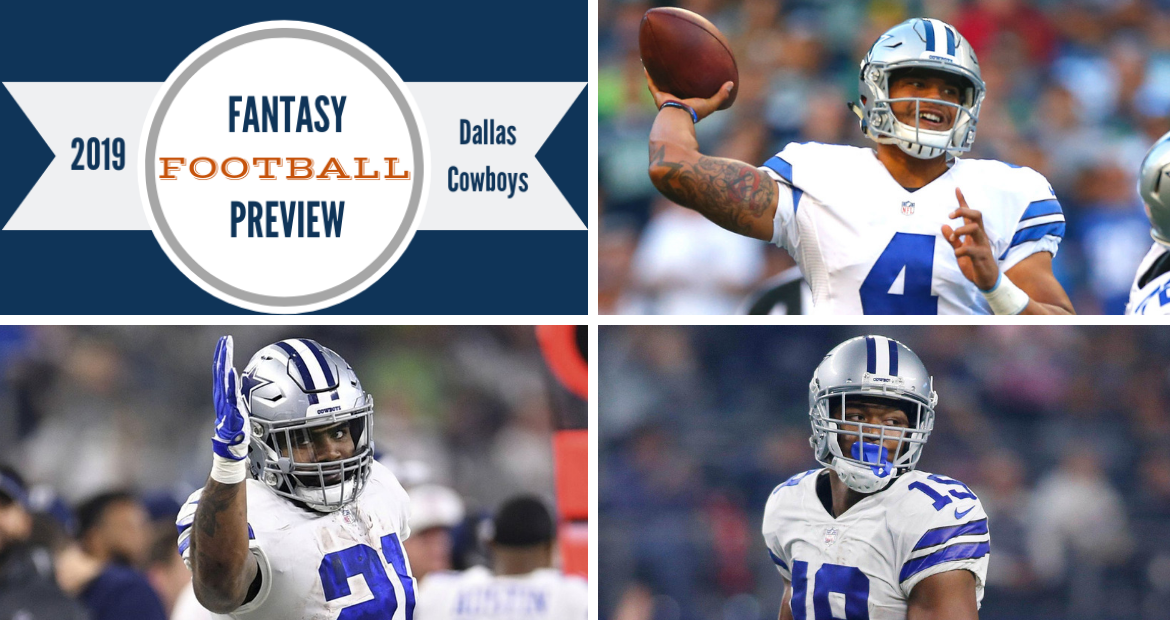
Fitz on Fantasy: 2019 Dallas Cowboys Buying Guide
With the preseason nearing, TFG fantasy expert Pat Fitzmaurice is breaking down the prospects for all 32 teams. Click here for a running list of teams, and check back often as teams are added on almost daily basis.
The 2018 Cowboys finished 22nd in points scored, 22nd in yards per game and 22nd in yards per play. All of those 22s make for a lovely tribute to Emmitt Smith, but the Dallas offense can do better.
In fact, this is the sort of offense fantasy owners can appreciate: quality skill-position talent with clearly defined roles, supported by a strong offensive line. But the Cowboys’ offensive design and play calling have been unadventurous, so team owner Jerry Jones showed offensive coordinator Scott Linehan the door and replaced him with former backup QB Kellen Moore.
Moore didn’t have the arm strength to throw a football out of his own shadow, yet he completed 69.8% of his passes, threw 142 TD passes and put most of the school passing records at Boise State out of reach while playing for offensive innovator Chris Petersen, now the head coach of the Washington Huskies. Petersen’s system uses myriad formations and a lot of pre-snap motion, so we might see more offensive variety in Dallas if indeed Moore borrows liberally from his old coach. It will be interesting to see what this offense looks like with new hands on the joystick.
Fantasy leaguers pay a disproportionate amount of attention to the handful of players at the top of draft boards, so there will be rivers of ink and many hours of podcast time spent parsing the differences between Saquon Barkley, Ezekiel Elliott, Christian McCaffrey and Alvin Kamara in the weeks to come. Barkley is currently the RB1 based on FantasyPros’ expert consensus rankings and average draft position. Elliot is RB2 among the experts and RB3 in ADP behind McCaffrey.
The two biggest drawbacks with Elliott are (1) that he seems primed for pass-catching pullback after his 77 receptions last season more than doubled his previous career high, and (2) that he’s a knucklehead.
It does seem unlikely that Zeke can match last year’s receiving totals (77-567-3), though it’s unclear what Moore has planned for Zeke in the passing game. But anyone concerned that the season-long presence Amari Cooper could negatively affect Elliott’s pass-catching role should consider that Zeke averaged 5.1 targets and 3.6 catches a game before Cooper’s midseason arrival, 7.4 targets and 6.5 catches with Cooper around.
Elliott’s knuckleheadedness is another matter. He was accused of, but not charged with, domestic violence, prompting the league to suspend him for six games in 2017. Elliott was caught on camera pulling down a woman’s shirt to expose her breast at a 2017 St. Patrick’s Day party in Dallas but was not disciplined. In May he was handcuffed but not arrested after knocking over a security guard at a music festival in Las Vegas – another incident that was caught on camera. No need for any tongue-clucking here, but just as some players can be fairly labeled as elevated injury risks, Zeke is an elevated disciplinary risk. For some, that might be a tiebreaker in sorting out the upper reaches of the RB position; others won’t give a fig.
Zeke’s productivity to date is beyond question. He’s averaged 131.2 yards from scrimmage, 0.85 touchdowns and 19.8 (half-PPR) fantasy points per game since coming into the league. I have him ranked RB2 behind only McCaffrey in half-PPR scoring. Zeke’s supporting cast is superior to Barkley’s, and his touch volume figures to be substantially higher than Kamara’s.
Rookie Tony Pollard is the favorite to be Zeke’s top backup. Pollard played behind Darrell Henderson at Memphis, but the Cowboys still thought enough of him to take him in the fourth round. Pollard was prolific as a pass catcher at Memphis, with 75 receptions for 994 yards over his last two seasons. The Cowboys also spent a seventh-round pick on Mike Weber of Ohio State, who has 4.47 speed and ran for 1,096 yards as a freshman.
You’d think the public would have a warmer embrace for Dak Prescott, who’s finished QB6, QB11 and QB10 in fantasy scoring over his first three seasons. But with an ADP of QB18, Dak is getting only clammy handshakes and halfhearted bro-hugs. Drafters probably realize that Prescott isn’t likely to extend his streak of three consecutive seasons with six TD runs, but Dak has never thrown more than 23 TD passes in a season and could clear that bar pretty easily.
With Dez Bryant’s career sideswiped by injuries and declining performance, there have been times when Dak’s most reliable wide receiver was Cole Beasley (who’s now in Buffalo). But the trade for Cooper and the drafting of young buck Michael Gallup have given Prescott a quality tandem of playmakers, and as noted earlier, Zeke has started contributing as a pass catcher, too.
Prescott is just entering his prime, and his ability as a runner can be so valuable in our little game. He’s a good value at his ADP.
Does Team Amari finally get to declare victory?
In recent years, some people were eager to note that Michael Crabtree consistently produced better TD totals than Amari Cooper during their time together in Oakland, yet Cooper was always more expensive in fantasy. Cooper was terrific after arriving in Dallas last year, catching 53 passes for 725 yards and six TDs in nine games. Crabtree, meanwhile, has drawn little interest in free agency and remains unsigned.
In your face, Team Crabtree.
Yardage numbers are more bankable than TD totals, and Cooper had always outperformed Crabtree in yardage and, especially, yards per target. Cooper has been a reliable yardage producer since coming into the league in 2015, clearing 1,000 yards in all but one of four seasons.
Coop is now in a nice spot with the Cowboys. He’s the uncontested alpha receiver, yet Gallup is dangerous enough to discourage opponents from rolling safety help toward Cooper. If Kellen Moore wants to use Cooper as a movable chess piece, well, Cooper has lined up all over the place early in his career – wide left, wide right and in the slot on either side.
With an ECR of WR12 and an ADP of WR14, Cooper looks like a rock-solid value.
Michael Gallup’s gait was lethargic early in his rookie season, starting at a trot before building to a late-season canter, culminating in a six-catch, 119-yard game in the playoff loss to the Rams. Gallup was sensational in two college seasons at Colorado State, with 176 catches for 2,690 yards and 21 touchdowns. His sub-50% catch rate last season isn’t that damning considering that his average depth of target of 14.4 yards.
With Cooper hogging targets, Gallup’s ceiling is somewhat limited, though he’s still an interesting growth stock. It’s a good bet that he’ll get more than the 68 targets he saw last year, and it’s not hard to imagine Gallup becoming startable in most leagues.
It’s harder to imagine Randall Cobb being startable since he hasn’t been fantasy-relevant since 2015. Granted, Cobb has been waylaid by injuries, missing 11 games over the past three seasons, but it’s hard to generate enthusiasm for a receiver who’s cleared 100 yards just twice in his last 37 regular-season games despite playing with Aaron Rodgers. Cobb had a 9-142-1 performance in Green Bay’s season-opening win over Chicago last year, then didn’t produce more than 43 receiving yards in any of his other eight games. He had some nice fantasy seasons earlier this decade, but Cobb is no longer draftable.
Allen Hurns is trying to come back from the grisly ankle injury he sustained in the January wild-card game against the Seahawks, and former Rams first-round pick Tavon Austin is still around as a cautionary tale for any NFL front office thinking about spending major draft capital on a fast, tiny receiver. (Best of luck with Marquise Brown, Ravens fans.)
Jason Witten’s fantasy outlook is less interesting than his decision to leave broadcasting and rejoin the Cowboys. Witten simply didn’t add much to the booth and was destined to fall well short in any comparison to his former teammate, Tony Romo, a natural talker who’s quickly become one of the best analysts we’ve ever heard.
Witten’s decision to leave broadcasting is understandable, but why play again and risk his well-being at age 37? Legacy means everything to some guys, and maybe Witten was hell-bent on being remembered as a player rather than as a mediocre analyst.
And Witten surely WILL be remembered as one of the finest tight ends of his era. We’re now in a different era, however, and the slow-moving Witten isn’t worth rostering despite the brand-name appeal.
Blake Jarwin might have been an interesting sleeper if Witten’s return hadn’t smothered any potential Jarwin value with a pillow. The third-year man from Oklahoma State raised eyebrows by catching seven passes for 199 yards and three TDs against the Giants in Week 17. Jarwin also had a seven-catch game against the Eagles in Week 14.
| PLAYER | FITZ RANK | ECR | ADP | ADVICE |
| Dak Prescott | QB14 | QB13 | QB18 | Solid choice |
| Ezekiel Elliott | RB2 | RB2 | RB2 | Yes, please |
| Amari Cooper | WR10 | WR12 | WR14 | Buy |
| Michael Gallup | WR46 | WR49 | WR57 | Decent value |
| Randall Cobb | WR82 | WR82 | WR65 | Not anymore |
| Jason Witten | TE32 | TE31 | TE25 | Too old |
ADP = Average Draft Position ECR = Expert Consensus Ranking (based on half-PPR scoring)



